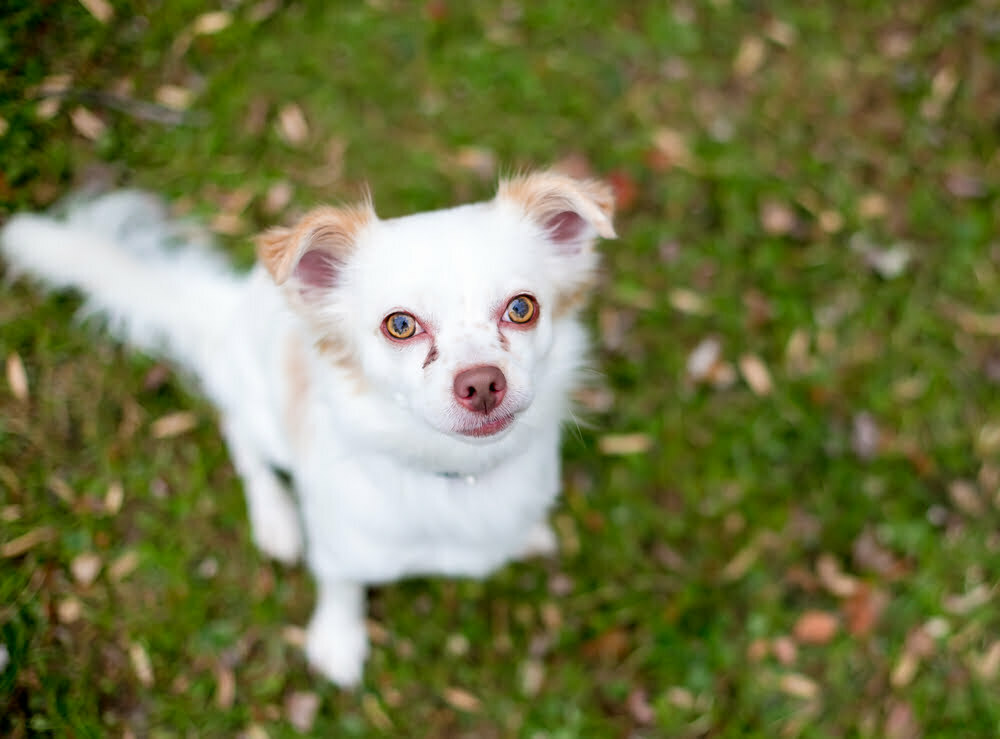Although they’re not harmful in any way, tear stains can cause your pup to have a permanently woeful expression and can emit an odd odor if left undealt with for too long.
Luckily, tear stains can be removed pretty easily. There are plenty of products currently on the market which claim they can remove tear stains and restore the flawless face of fur you fell in love with when you brought your dog home.
But are they really that safe?
This article is going to take a look at some of the ways you can remove your dog’s tear stains naturally and will ultimately decide which is the best tear stain remover for dogs.

Does Tap Water Cause Tear Stains in Dogs?
Some breeds are naturally more prone to tear stains than others, although white-coated dogs in general tend to show them pretty commonly.
Breeds like Toy Poodles, Maltese, Shih Tzu, and Lhasa Apsos, which are small with long face hairs also suffer from tear stains.
Genetics means that dog breeds like this are predisposed to tightness in the eyelid and the hair around the eye area can act as a sort of ‘wick’ that pulls teardrops onto the face.
However, if your dog’s water has a high mineral content this could also be contributing to your dog’s tear stains.
You’ll know if this is the case as it’s often accompanied by staining around the mouth. Simply swap out tap water for filtered and the tear stains should ease up.
Does Apple Cider Vinegar Help Tear Stains?
Apple cider vinegar has many well known benefits for both humans and animals, and you’ll be happy to learn that it can also be used to help remove or reduce the appearance of your dog’s tear stains.
However, you do need to ensure you only administer it in the proper dose.
It’s recommended by veterinarians and animal health experts that apple cider vinegar should never be used as a topical solution for animals due to its high acidity.
If given on its own, the apple cider vinegar could potentially worsen the issue and irritate the skin if applied directly.
Instead, you should only use apple cider vinegar to treat this condition by adding it to your pet’s food. If you have some already lying around the house, you probably know that it has a pretty distinctive smell and taste.
This can be particularly bitter to dogs due to their heightened senses, so you’ll need to make sure you mix the apple cider vinegar in with the food well to try and mask the taste, or your dog might just turn their nose up at their dinner!
Does Coconut Oil Remove Dog Tear Stains?
It was only recently that products containing the antibiotic tylosin tartrate were recalled after failing to become FDA approved for use around the eye area, due to a tendency to cause irritation and inflammation of the skin.
As a result, more people are looking for natural solutions for tear stains, and coconut oil is a great alternative to remove dog tear stains.
Coconut oil is safe to use around your dog’s eyes thanks to the natural antifungal, antibiotic and anti-inflammatory agents it contains.
This is also what makes it such a great remover of tear stains, provided you make sure to only use organic, unrefined coconut oil where there is no chance it could contain any chemicals or pesticides that could react with your dog’s skin.

Does Yoghurt Help Dog Tear Stains?
Yeast is another common cause of tear stains among dogs, therefore as long as you’ve cleared it with your veterinarian beforehand, giving your dog a probiotic like yogurt may help with this condition, as it can be an effective preventative measure.
It should go without saying (we hope), that you should never put yogurt near your dog’s eyes, as this is an extremely sensitive area and it’s likely a good way to make sure they’re not very happy with you. Instead, you should administer yogurt to your dog orally.
Simply mix 1 teaspoon of plain yogurt into your dog’s food twice a day, or you can even let them enjoy licking the yogurt off of the spoon if they’ve been especially well behaved, or if they’re just being particularly cute that day. Those puppy-dog eyes get us every time.
What is the Best Dog Tear Stain Remover?
As a removing agent, coconut oil is the best option out of all three we’ve included here when it comes to dog tear stains.
It’s natural, skin-friendly, and irritation-free, but most importantly, it’s completely safe to use as well as being highly effective, unlike some big-name brands.
If you are looking to purchase a dog tear stain remover, we would recommend trying Burt’s Bees for Pets natural tear stain remover which contains a chamomile blend that gently works to remove tear stains and any particles or dirt trapped near your dog’s eye area.
Another popular stain remover is this option from Araca, which can be used for both dogs and cats.
The natural ingredients used in this formula mean that it is safe for pet use, and it contains Dead Sea minerals that work to penetrate your pet’s hair to remove tear stains.
We do stand by coconut oil as the best stain remover, however, due to it being cheap and often something you’ll find already lying somewhere at the back of your pantry or cupboards.
You’ll never be stuck for a stain remover, nor will your dog’s eyes be stuck together, period.
Final Thoughts
We hope you’ve found this article useful, and that we’ve reassured you that your dog’s tear stains can be removed as well as provided some helpful methods to safely remove them.
If you try these methods and see no improvement, speak to your veterinarian so they can run tests if they feel they need to, as sometimes, tear stains can be a sign of an underlying health issue. Most of the time, however, they’re harmless.
